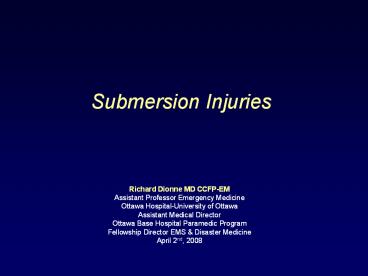Submersion Injuries - PowerPoint PPT Presentation
1 / 20
Title:
Submersion Injuries
Description:
Submersion Injuries Richard Dionne MD CCFP-EM Assistant Professor Emergency Medicine Ottawa Hospital-University of Ottawa Assistant Medical Director – PowerPoint PPT presentation
Number of Views:67
Avg rating:3.0/5.0
Title: Submersion Injuries
1
Submersion Injuries
- Richard Dionne MD CCFP-EM
- Assistant Professor Emergency Medicine
- Ottawa Hospital-University of Ottawa
- Assistant Medical Director
- Ottawa Base Hospital Paramedic Program
- Fellowship Director EMS Disaster Medicine
- April 2nd, 2008
2
Near Drowning Objectives
- Understand causal conditions
- Differentiate between fresh salt water
drownings - Identify potential injuries
- Select appropriate diagnostic management
- Consider treatment of hypothermia trauma
3
Definitions
- Drowning
- terminal outcome from submersion event
- Near-drowning AHA no longer uses
- Submersion Injuries
- survival, at least temporarily, after
suffocation in a liquid medium - 3rd most common cause of accidental death
overall, leading cause in lt 5 yo - ETOH / Drugs often associated
4
Immersion Syndrome
- Syncope secondary to cardiac dysrhythmias on
sudden contact with water at least 5oC lt body T - QT prolongation massive release of
catecholamines plus vagal stimulation - gtasystole and VF
- Resultant LOC leads to drowning
5
Risk Factors
- Inability to swim (overestimation of capabilities
- Risk taking behaviour
- Substance abuse (in gt50 of adult drownings)
- Inadequate supervision (bathtub)
- Concomitant conditions trauma, seizure, CVA,
cardiac event
6
Pathophysiology
- Aspiration of 1-3 mL/kg destroys integrity of
pulmonary surfactant - (? lung compliance)
- Alveolar collapse, atelectasis,
- Non-cardiogenic pulmonary edema (ARDS),
Intrapulmonary shunting, - V/Q mismatch
7
End Organ Effect
- Profound hypoxia
- Respiratory acidosis, ARDS
- Cardiovascular collapse
- Neuronal injury
- . Death
8
Salt vs Fresh Water Does it Make a Difference?
- Historically felt to affect electrolytes, fluid
shifting, hemolysis - Intravascular abnormalities do not occur until
aspirated water gt 11 mL/kg - Most aspirate lt4 mL/kg
- Review of 91 submersion victims, no pt required
emergent intervention for electrolyte abN - No significant clinical difference between the
two!
9
Management of Care
- Prehospital
- Emergency
- Inpatient
10
Prehospital
- On scene
- Immediate Rescue Breathing (even before out of
water) Heimlich not proven - Bystander CPR (pulse check 30 sec.)
- Consider trauma C-spine precautions
- Remove wet clothing, passive exernal rewarming
(Hypothermia!)
11
Emergency Department
- ABCs
- Early airway management
- Cardiac monitor, CORE (rectal) temp
- Immediate rewarming (Hypothermia)
- Passive External
- Active External
- Active Internal
12
Inpatient Management
- Goal prevent further secondary neurologic injury
and minimise end-organ damage.
13
Submersion Injuries
- Gen hypothermia, trauma
- GI vomiting (swallow gtgt aspirate)
- Respiratory
- ve pressure ventilation leads to gastric
distention, risk of aspiration - Aspiration of particulate contaminants
- Hypoxia from direct surfactant effects
- ARDS
14
Submersion Injuries
- CVS dysrhythmias
- CNS initial hypoxic injury or secondary
reperfusion injury with resuscitation - Renal ARF due to lactic acidosis, prolonged
hypoperfusion, rhabdomyolysis - Heme coagulopathies
15
What Investigations Do You Need?
- ECG for dysrhythmias, prolonged QT
- ABG any resp signs/symptoms
- Labs electrolytes, renal function, CBC, glucose
although usually N - Screening for ETOH, drugs
- CXR may underestimate severity initially
16
Factors Affecting Survival
- Age
- Water temperature
- Duration degree of hypothermia
- Diving reflex
- Resuscitation efforts
- Prior medical conditions
17
Hypothermia Good or Bad??
- Lowers cerebral metabolic rate, neuroprotective
- Diving reflex shunting of blood centrally in
response to cold water stimulus - Causes bradycardia apnea, decreased metabolic
consumption - Prolonged duration of submersion tolerated
- Cold water speeds development of exhaustion, LOC
and dysrhythmias
18
Poor Prognostic Factors
- gt 10 minutes submersion
- CPR initiated gt10 min after rescue
- Severe acidosis (pH lt 7.1)
- Unreactive pupils
- GCS 3 (comatose)
- Hypothermia in ED ?
- lt 3 yo
- Need for ongoing CPR
- Lack of spontaneous movement at 24hrs
19
Who can go home?
- Asymptomatic on presentation
- Maintains normal room air sat
- No CXR or ABG abnormalities
- D/C after 8 hour observation
20
Submersion Injuries Overview
- Immediate resuscitative efforts is key!
- Consider associated trauma, ETOH/drugs
- Development of pulmonary injury may take time,
initial CXR may be normal - No clinical difference b/w salt fresh H2O
- Majority of treatment is supportive, rewarming
not underestimate Prevention !!! - Monitor x 6-8 hr for asymptomatic pt with normal
investigations






























